- I nfographics
- Show AWL words
- Subscribe to newsletter
- What is academic writing?
- Academic Style
- What is the writing process?
- Understanding the title
- Brainstorming
- Researching
- First draft
- Proofreading
- Report writing
- Compare & contrast
- Cause & effect
- Problem-solution
- Classification
- Essay structure
- Introduction
- Literature review
- Book review
- Research proposal
- Thesis/dissertation
- What is cohesion?
- Cohesion vs coherence
- Transition signals
- What are references?
- In-text citations
- Reference sections
- Reporting verbs
- Band descriptors
Show AWL words on this page.
Levels 1-5: grey Levels 6-10: orange
Show sorted lists of these words.
Any words you don't know? Look them up in the website's built-in dictionary .
Choose a dictionary . Wordnet OPTED both

Writing objectively How and when to use an impersonal tone
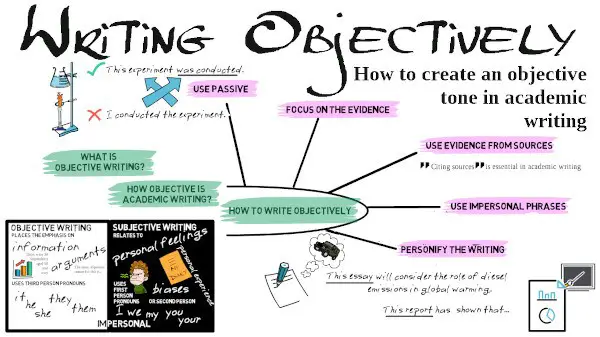
For another look at the same content, check out the video on YouTube (also available on Youku ). There is a worksheet (with answers and teacher's notes) for this video.
Academic writing is generally impersonal and objective in tone. This section considers what objective writing is , how objective academic writing is , then presents several ways to make your writing more objective . There is also an academic article , to show authentic examples of objective language, and a checklist at the end, that you can use to check the objectivity of your own writing.
What is objective writing?
Objective writing places the emphasis on facts, information and arguments, and can be contrasted with subjective writing which relates to personal feelings and biases. Objective writing uses third person pronouns (it, he, she, they), in contrast to subjective writing which uses first person pronouns (I, we) or second person pronoun (you).
How objective is academic writing?
Although many academic writers believe that objectivity is an essential feature of academic writing, conventions are changing and how much this is true depends on the subject of study. An objective, impersonal tone remains essential in the natural sciences (chemistry, biology, physics), which deal with quantitative (i.e. numerical) methods and data. In such subjects, the research is written from the perspective of an impartial observer, who has no emotional connection to the research. Use of a more subjective tone is increasingly acceptable in areas such as naturalist research, business, management, literary studies, theology and philosophical writing, which tend to make greater use of qualitative rather than quantitative data. Reflective writing is increasingly used on university courses and is highly subjective in nature.
How to write objectively
There are many aspects of writing which contribute to an objective tone. The following are some of the main ones.
Use passive
Objective tone is most often connected with the use of passive, which removes the actor from the sentence. For example:
- The experiment was conducted.
- I conducted the experiment.
- The length of the string was measured using a ruler.
- I measured the length of the string with a ruler.
Most academic writers agree that passive should not be overused, and it is generally preferrable for writing to use the active instead, though this is not always possible if the tone is to remain impersonal without use of I or other pronouns. There is, however, a special group of verbs in English called ergative verbs , which are used in the active voice without the actor of the sentence. Examples are dissolve, increase, decrease, lower, and start . For example:
- The white powder dissolved in the liquid.
- I dissolved the white powder in the liquid.
- The white powder was dissolved in the liquid.
- The tax rate increased in 2010.
- We increased the tax rate in 2010.
- The tax rate was increased in 2010.
- The building work started six months ago.
- The workers started the building work six months ago.
- The building work was started six months ago.
Focus on the evidence
Another way to use active voice while remaining objective is to focus on the evidence, and make this the subject of the sentence. For example:
- The findings show...
- The data illustrate...
- The graph displays...
- The literature indicates...
Use evidence from sources
Evidence from sources is a common feature of objective academic writing. This generally uses the third person active. For example:
- Newbold (2021) shows that... He further demonstrates the relationship between...
- Greene and Atwood (2013) suggest that...
Use impersonal constructions
Impersonal constructions with It and There are common ways to write objectively. These structures are often used with hedges (to soften the information) and boosters (to strengthen it) . This kind of language allows the writer to show how strongly they feel about the information, without using emotive language, which should be avoided in academic writing.
- It is clear that... (booster)
- It appears that... (hedge)
- I believe that...
- There are three reasons for this.
- I have identified three reasons for this.
- There are several disadvantages of this approach.
- This is a terrible idea.
Personify the writing
Another way to write objectively is to personify the writing (essay, report, etc.) and make this the subject of the sentence.
- This essay considers the role of diesel emissions in global warming.
- I will discuss the role of diesel emissions in global warming.
- This report has shown that...
- I have shown that...
In short, objective writing means focusing on the information and evidence. While it remains a common feature of academic writing, especially in natural sciences, a subjective tone is increasingly acceptable in fields which make use of qualitative data, as well as in reflective writing. Objectivity in writing can be achieved by:
- using passive;
- focusing on the evidence ( The findings show... );
- referring to sources ( Newbold (2021) shows... );
- using impersonal constructions with It and There ;
- using hedges and boosters to show strength of feeling, rather than emotive language;
- personifying the writing ( This report shows... ).
Bailey, S. (2000). Academic Writing. Abingdon: RoutledgeFalmer
Bennett, K. (2009) 'English academic style manuals: A survey', Journal of English for Academic Purposes , 8 (2009) 43-54.
Cottrell, S. (2013). The Study Skills Handbook (4th ed.) , Basingstoke: Palgrave MacMillan.
Hinkel, E. (2004). Teaching Academic ESL Writing: Practical Techniques in Vocabulary and Grammar . Mahwah: Lawrence Erlbaum Associates Inc Publishers.
Hyland, K. (2006) English for Academic Purposes: An advanced resource book . Abingdon: Routledge.
Jordan, R. R. (1997) English for academic purposes: A guide and resource book for teachers . Cambridge: Cambridge University Press.
Example article
Below is an authentic academic article. It has been abbreviated by using the abstract and extracts from the article; however, the language is unchanged from the original. Click on the different areas (in the shaded boxes) to highlight the different objective features.
Title: Obesity bias and stigma, attitudes and beliefs among entry-level physiotherapy students in the Republic of Ireland: a cross sectional study. Source: : https://www.sciencedirect.com/science/article/pii/S0031940621000353

GET FREE EBOOK
Like the website? Try the books. Enter your email to receive a free sample from Academic Writing Genres .
Below is a checklist for using objectivity in academic writing. Use it to check your writing, or as a peer to help. Note: you do not need to use all the ways given here.
Next section
Read more about writing critically in the next section.
- Critical writing
Previous section
Go back to the previous section about using complex grammar .
- Complex grammar

Author: Sheldon Smith ‖ Last modified: 05 February 2024.
Sheldon Smith is the founder and editor of EAPFoundation.com. He has been teaching English for Academic Purposes since 2004. Find out more about him in the about section and connect with him on Twitter , Facebook and LinkedIn .
Compare & contrast essays examine the similarities of two or more objects, and the differences.
Cause & effect essays consider the reasons (or causes) for something, then discuss the results (or effects).
Discussion essays require you to examine both sides of a situation and to conclude by saying which side you favour.
Problem-solution essays are a sub-type of SPSE essays (Situation, Problem, Solution, Evaluation).
Transition signals are useful in achieving good cohesion and coherence in your writing.
Reporting verbs are used to link your in-text citations to the information cited.
Subjective vs. Objective Essay: Examples, Writing Guides, & Topics
Subjective or objective essay writing is a common task students have to deal with. On the initial stage of completing the assignment, you should learn how to differentiate these two types of papers. Their goals, methods, as well as language, tone, and voice, are different.
Our specialists will write a custom essay specially for you!
A subjective essay focuses on the writer’s personal opinion, while an objective one represents valid facts. So, be careful when composing an objective paragraph or paper. Don’t let your beliefs take over real arguments supported by substantial evidence.
In short, differences between these styles concern the following:
- The ground for objective essays is facts; for subjective essays – personal opinions and beliefs.
- Objective papers report the findings from scientific sources, while subjective ones describe the writer’s thoughts.
- The objective essay’s goal is to help the reader make a decision. Subjective writing aims to reflect the author’s vision of the issue.
So, if you face this task for the first time, you may need some explanations. Custom-writing.org experts prepared a list of tips on how to write objective and subjective essays. Some topics, as well as objective and subjective writing examples, will also be useful.
- 🆚 Subjective vs. Objective
🔗 References
🆚 subjective vs. objective essays.
First and foremost, let’s find out the critical differences between the writing styles. Take a look at the following table and shed light on this issue.
An objective essay is a presentation of the material with no independent opinion involved. Only facts matter in this paper, and only facts can back up some assertions. Writing subjective essays implies introducing your standpoint on a particular problem.
Just in 1 hour! We will write you a plagiarism-free paper in hardly more than 1 hour
📋 How to Write an Objective Essay
Writing any essay consists of three parts: preparation, the actual writing, and revision. During the first one, you need to decide on your topic and do a little research. You can see how it looks in a real example.
Objective Essay Example: The Portrayal of Odysseus
In Odyssey, Homer portrays Odysseus, the king of Ithaca, as the true epic hero. The depiction of Odysseus is thoughtfully knitted together with the themes of love and loyalty that further magnify it, painting a holistic picture of a long 10-year journey home. Although it can be argued that some of Odysseus’s personality traits he displays cannot be applied to a true hero, he is still depicted following a very specific heroic archetype.
Now, let’s get into more detail!
Objective Essay Topics
If you’ve decided to write an objective essay, you need to come up with a topic. The topic gives a reader a brief overview of what will be covered in the paper.
Here are ten great examples:
- While the differences between Italy and Spain are evident, the resemblances are striking.
- There are several similarities between the movies “Deep Impact” and “Armageddon.”
- Compare and contrast the capitals of two English-speaking countries.
- Somatic symptoms in people with PTSD can be influenced by age, gender, and avoidance.
- Some might argue, but being overweight carries a social stigma.
- Environmental factors contribute to the phenotypic expression of psychological disorders.
- Although the exact reason remains unclear, depression is affected by sex, gender, hormonal changes, and age.
- When comparing and contrasting the Bible and Quran, it seems that they have more similarities than differences.
- Musical ability is the result of influence on the person from outside.
- In comparison to extroverts, introverts draw power from within themselves to use it in future activities.
Objective Essay Structure
We shall continue with exploring an essay structure. Note that the parts described below are essential for any essay.
Receive a plagiarism-free paper tailored to your instructions. Cut 20% off your first order!
- Introduction . The introduction is usually the part that broadly describes the topic and gets the interest of the reader. This part of the paper should cover some background information and present the purpose.
- Hypothesis . In case your essay has one, state it in your introduction. A hypothesis includes information about how you intend to prove or refute the claim. It briefly describes the way you intend to do so.
- Arguments . Present one side of the argument. In the next paragraph, present the opposing one, using such words as “however,” “nevertheless,” and “although.” The task is to provide the readers with two sides of the argument.
- Evidence . Provide the evidence for all of your points. Keep the balance in providing proof and refutal. Omit your personal opinion, rather than include the evidence you find informative and convincing.
- Conclusion . Summarize the arguments both for and against the position. While remaining objective, shortly go over the information you presented as evidence. If the instructions require a personal opinion, in conclusion, you might write one. In other cases, briefly recap the parts of the essay. Shorten sentence generator would be greatly beneficial in such endeavor.
📜 How to Write a Subjective Essay
As we’ve mentioned earlier, a subjective essay represents the author’s vision of a particular issue. You have an opportunity to introduce your point of view without supporting your ideas with evidence from the primary sources. However, make sure your arguments are still logical and adequate.
Now see how to write a subjective essay in the sections below.
Subjective Writing Example
A well-chosen topic is the vital determinant of a successful essay. Yet, the process of selecting an idea for your paper might be challenging. That’s why you may find our example helpful.
The rapid pace of development of modern technologies increases the demand for oil and gas every year. A considerable amount of these resources is necessary to maintain both industrial enterprises and private equipment. Despite active production, there are still many unexplored places on Earth, potentially rich in oil and gas deposits. However, while making them public would help solve the existing problem, I’m afraid I disagree with this proposal.
Subjective Essay Topics
Check our list of subjective essay topics, choose the one you like the most, or inspire and come up with your idea!
- The fake and too glamorous life presented in social media leads to the development of an inferiority complex among teenagers.
- The information flows within the country should not be controlled by the governments.
- Since developed nations provoked the climate crisis, they should take full responsibility for their past actions and reduce carbon emissions in the atmosphere.
- Cyberbullying should be a matter of the same importance as physical abuse.
- Remote learning opens more opportunities and expands the students’ horizons.
- Instead of catching up with fashion trends, it is better to develop your unique style.
- People should have enough rest to reduce the levels of anxiety and decrease the chances of depression.
- Studying abroad is an experience worth trying.
- Planning and scheduling are perfect strategies to deal with procrastination.
- While applying for a job position, work experience is more significant than having a degree.
📝 Subjective Essay Structure
When you deal with this task, you have full freedom of choice. You can decide for yourself what idea to support and what arguments to present. Still, you have to structure even a subjective essay properly.
Get an originally-written paper according to your instructions!
Here are the elements you have to include in your paper:
- grab the readers’ attention;
- introduce your subject;
- state your position in the thesis statement.
Important note: your thesis should be clear and straightforward. Let your audience understand your opinion.
- Description . Dive deeper into your topic and describe your issue in detail. However, don’t go too far. Avoid including irrelevant facts and unnecessary information. Follow the principle “quality over quantity” to keep your reader engaged.
- Opinion . After describing your issue, move to the most crucial part of your essay—opinion. State it clearly and concisely. Although you don’t need to provide any evidence from scholarly sources, your ideas should be supported by substantial arguments or examples from your personal life.
- Conclusion . In the last paragraph of your subjective essay, restate your thesis statement. Don’t introduce any other ideas here. To make your paper more dynamic, ask a provocative question at the end. It may motivate your reader for further investigation of your subject.
A helpful tip:
Before submitting your work, make sure it is coherent. Check if all of your ideas follow the logical flow. To avoid redundancy and wordiness, mix shorter sentences with longer ones and apply transitional phrases. Polish your essay, turn it in, and wait for your perfect grade.
Thanks for reading the page! Share it with your peers who may need some guidance as well. Our writers are ready to explain any other essay type , not only objective or subjective ones.
Learn more on this topic:
- How to Write an Expository Essay in Simple Steps
- Nursing Reflective Essay Example and Guidelines for Students
- Essay on Dengue Fever: How to Write + Free Examples
- French Essay Writing: How-to Guide and Examples
- How to Write a Rebuttal Essay: Jackie Michael, Pen and the Pad
- Writing Objectively: OWLL, Massey University
- Subjective vs Objective: Difference and Comparison, Diffen
- Objective and Subjective Claims: TIP Sheet, Butte College
- Evidence: The Writing Center, University of North Carolina at Chapel Hill
- Organizing Your Argument: Purdue Online Writing Lab, College of Liberal Arts, University of Purdue
- Argumentative Paper Format: Courtesy the Odegaard Writing & Research Center, University of Washington
- How Do I Write an Intro, Conclusion, & Body Paragraph: LSA Sweetland Center for Writing, the University of Michigan
- Share to Facebook
- Share to Twitter
- Share to LinkedIn
- Share to email

Writing All About Me paragraph is probably one of the most usual assignments. For example, students might write it when entering an academic institution. Such work gives an opportunity to introduce yourself, your skills, and goals. However, it is not the only possible situation.

Coral reefs can be called one of the most amazing things created by nature. These structures can be found in tropical and temperate waters. Like many other unique natural phenomena, coral reefs are influenced by human activity these days. This negative impact is one of the significant issues to consider when...

An ambition essay focuses on one’s strong desire to achieve success in one or several areas. It might be one’s career, finance, family, art, health, or all at once. Writing an ambition essay, you might want to consider your own life or examples from the world literature. You can describe...
![an essay on objective Essay for Primary School: Simple Guide for Kids [with Samples]](https://custom-writing.org/blog/wp-content/uploads/2020/12/pupils-raising-hand-classroom-284x153.jpg)
The age of primary school students ranges from 5 to 11 years. At this stage of education, children start developing their writing skills. They make their first steps to analyzing and proving their points of view. Besides, they study how to write an essay for elementary school. Correctly preparing all...

Canadian identity is something that has become really important for many Canadians in the past fifty years. Canada is a big, multinational country with its own traditions, culture, and history. However, because of quite a large number of foreigners and even Americans, its culture and people are associated with the...

Let’s say you received a task to write an essay about cars. The topic might be interesting for you, but you may still have no idea how to organize your paper. Well, this article is for you.

Smoking can be viewed as one of the trendy habits. Numerous teenagers try it since they think that it is cool or can help them socialize. Often students start smoking due to stress or mental illnesses. But is it okay? Educators tend to give different written assignments, which may disclose...
![an essay on objective Child Labor Essay: Thesis, Examples, & Writing Guide [2024]](https://custom-writing.org/blog/wp-content/uploads/2020/12/child-working-in-cambodia-e1565628499749-284x153.jpg)
Children have always been apprentices and servants all over human history. However, the Industrial Revolution increased the use of child labor in the world. It became a global problem that is relevant even today when such employment is illegal.

Dissertation critique writing develops the students’ critical and logical thinking abilities. When composing, the students learn to analyze the works conducted by other researchers. To critique a dissertation, you should: Thoroughly read the paper.Take notes and summarize the text (you can even try and use auto summarizer for that).Interpret and...

An opinion essay is a formal piece of writing which presents the author’s point of view on a particular subject supported by reasoning and examples. The opposing viewpoint is also suggested, but it is followed by arguments that show its inconsistency. Take a look at the guide prepared by Custom-writing experts to...

So, you need to accomplish your discursive essay writing. The typical questions most students ask are: How do you write it? What is discursive essay? A discursive essay is an academic paper that involves a discussion on a particular topic. It is usually assigned to college students. You may be...

How to write a narrative essay? To do that, you need to know what a narrative essay is. It is an academic text usually written as a story and containing all the usual elements of a story. Narrative essays are often personal, experiential, and creative. Still, they should be made...
Very helpful to make my assignment. Thank you so much!

Glad to know that. Thank you very much, Farhana!
Subjective and reflective.
That’s right, Raj 🙂
Thank you for this information. I submitted my subjective essay, which was rejected by my teacher for lack of an attractive hook. After reading your info on writing subjective essays, I know what I should change in my paper to get a good grade.
Thank you so sweet for these wonderful tips for objective essays! I love your blog, and it’s really helpful one online! Keep it up!
This is what I need to complete my paper. Your subjective essay writing secrets are appropriate for students who can’t cope with their essays themselves. Even those who write a paper for the first time will complete their subjective essays without any problems.
I really appreciate your help in posting all this information for students — this time you’ve taught me how to write an objective essay. You’re real specialists in writing all types of papers!
- How to Cite
- Language & Lit
- Rhyme & Rhythm
- The Rewrite
- Search Glass
How to Write an Objective Essay
Objectivity in essay writing is important in order for the writer to clearly state both sides of an argument without displaying a bias toward one side or the other. When students are given essay titles to complete, not all titles call for objectivity, but the main question will always point to a pro-and-con situation. Personal opinions in essays are not usually accepted unless they are written with objectivity and backed up by references and proof.
Begin your essay with an introductory paragraph that presents the purpose of the essay. If there is a hypothesis involved, state how you intend to prove or disprove the hypothesis and broadly explain how you intend to do so. Details at this point are not necessary, as they will be covered in the main body of your essay.
State one side of the argument and report the evidence and findings that support the statement you are making. Leave out how you personally feel about the issue but do bring in supporting evidence that you find compelling. Remain objective when you compose an essay by keeping your arguments balanced in support or for rebuttal of the hypothesis.
Read back over the essay as you write and remain focused on your objectivity. To be objective is the opposite of being subjective. Being objective is being able to remove yourself from the personal emotions and thoughts you may have about the subject, while being able to examine fairly and critique both sides of the argument you are discussing.
State the opposing argument in your next paragraph or chapter. Use words and phrases that express the change of direction within the essay, such as “however,” “although” and “on the other hand.” Include comments that contrast the preceding paragraphs. For example, you may be writing about Freud, and your contrasting statement would include something like “While Freud argued that ... Jung disagreed with this by stating ...” Your goal in the rebuttal argument is to compel readers to see both sides and draw their own conclusions.
Conclude your essay by summing up the arguments both for and against the position. Again, remaining objective means reiterating your argument in a simplified form to remind readers what they have heard and, hopefully, learned from your statements. Your aim is to gear the readers up for a short evaluation of the topic of discussion. State the facts you have laid out and remind the readers of your own objectivity by using an equal number of references and arguments from both sides. If your essay requires you to conclude with an opinion, then you should compose and add one. If the essay simply requests an argumentative approach, then lay out the two sides and state the conclusion as the recap of the elements of the essay.
Jackie Michael has been a freelance writer since 2007. Her work has appeared on various websites, including Autos.com and CarsDirect. She holds a Bachelor of Arts in psychology and sociology from East London University.
Skip to Content
Massey University
- Search OWLL
- Handouts (Printable)
- Pre-reading Service
- StudyUp Recordings
- StudyUp Postgraduate
- Academic writing
- Intro to academic writing
- What is academic writing?
Writing objectively
- Writing concisely
- 1st vs. 3rd person
- Inclusive language
- Te Reo Māori
- Assignment planning
- Assignment planning calculator
- Interpreting the assignment question
- Command words
- Organising points
- Researching
- Identifying academic sources
- Evaluating source quality
- Editing & proofreading
- Apostrophes
- Other punctuation
- Active voice
- American vs. British spelling
- Conditionals
- Prepositions
- Pronoun Reference
- Sentence fragments
- Sentence Structure
- Subject-verb agreement
- Formatting and layout
- Word limits and assignment length
- Commonly confused words
- How assignments are marked
- Marking guides
- Getting an A
- Levels of assessment
- Using feedback
- Professional emails
- Forum posts
- Forum netiquette guidelines
- Sharing personal information
- Writing about personal experiences
- Assignment types
- What is an essay?
- Essay planning and structure
- Introduction
- Thesis statement
- Body paragraphs
- Essay revision
- Essay writing resources
- What is a report?
- Report structure
- Analysing issues for a report
- Business report
- What is a business report?
- Business report structure
- Inductive vs. deductive reports
- Other kinds of business communication
- Business report format and layout
- What is a lab report?
- Lab report structure
- Science lab report writing resources
- Psychology lab report writing resources
- Lab report body paragraphs
- Literature review
- What is a literature review?
- Writing a literature review
- Literature review structure
- Literature review writing resources
- Research proposal
- Writing a research proposal
- Research proposal structure
- Other types
- Article critique
- Book review
- Annotated bibliography
- Reflective writing
- Oral presentation
- Thesis / dissertation
- Article / conference paper
- Shorter responses
- Computer skills
- Microsoft Word
- Basic formatting
- Images, tables, & figures
- Long documents
- Microsoft Excel
- Basic spreadsheets
- Navigating & printing spreadsheets
- Charts / graphs & formulas
- Microsoft PowerPoint
- Basic skills
- Advanced skills
- Distance study
- Getting started
- How to study
- Online study techniques
- Distance support
- Reading & writing
- Reading strategies
- Writing strategies
- Grammar resources
- Listening & speaking
- Listening strategies
- Speaking strategies
- Maths & statistics
- Trigonometry
- Finance formulas
- Postgraduate study
- Intro to postgrad study
- Planning postgrad study
- Postgrad resources
- Postgrad assignment types
- Referencing
- Intro to referencing
- What is referencing?
- Why reference?
- Common knowledge
- Referencing styles
- What type of source is this?
- Reference list vs. bibliography
- Referencing software
- Quoting & paraphrasing
- Paraphrasing & summarising
- Paraphrasing techniques
- APA Interactive
- In-text citation
- Reference list
- Online material
- Other material
- Headings in APA
- Tables and Figures
- Referencing elements
- 5th vs. 6th edition
- 6th vs. 7th edition
- Chicago style
- Chicago Interactive
- About notes system
- Notes referencing elements
- Quoting and paraphrasing
- Author-date system
- MLA Interactive
- Abbreviations
- List of works cited
- Captions for images
- 8th vs 9th edition
- Oxford style
- Other styles
- Harvard style
- Vancouver style
- Legal citations
- Visual material
- Sample assignments
- Sample essay 1
- Sample essay 2
- Sample annotated bibliography
- Sample book review
- Study skills
- Time management
- Intro to time management
- Procrastination & perfectionism
- Goals & motivation
- Time management for internal students
- Time management for distance students
- Memory skills
- Principles of good memory
- Memory strategies
- Note-taking
- Note-taking methods
- Note-taking in lectures
- Note-taking while reading
- Digital note-taking
- Reading styles
- In-depth reading
- Reading comprehension
- Reading academic material
- Reading a journal article
- Reading an academic book
- Critical thinking
- What is critical thinking?
- Constructing an argument
- Critical reading
- Logical fallacies
- Tests & exams
- Exam & test study
- Planning exam study
- Gathering & sorting information
- Reviewing past exams
- Phases of revision
- Last-minute study strategies
- Question types
- Short answer
- Multi-choice
- Problem / computational
- Case-study / scenario
- Open book exam
- Open web exam or test
- Take home test
- In the exam
- Online exam
- Physical exam
Being objective suggests that you are concerned about facts and are not influenced by personal feelings or biases. Part of being objective is being fair in your work. Try to consider both sides of an argument and avoid making value judgements by using words such as wonderful or appalling. Being objective also makes your work more professional and credible.
Techniques for making your writing more objective
Be explicit in expressing your ideas:.
- several ⇒ 10
- most of the population ⇒ 70%
- some time ago ⇒ three years ago; or in 2006
Avoid intensifiers which can tend to exaggerate your writing in an imprecise, subjective way:
- For example, awfully, very, really.
Part of being objective is being balanced in your work, professional and believable:
- Try to avoid making value judgements through use of words such as amazing or dreadful.
First vs. third person
Pronouns are a set of words that replace nouns. They can be used to make your work less complicated and less repetitive. Examples of pronouns include:
- First person: I, we, me, us
- Second person: you
- Third person: he, she, it, they, him, her, them
For some assignments, it is appropriate to use the first person (e.g. reflective writing). However, for other assignments the third person is preferred. Sometimes a mixture of the first and third person should be used for different purposes. So, check your assignment guidelines for each assignment, as it will differ for different assignment types , different style guides, and different disciplines. If you are unsure, then check with your course coordinator. For more on this see 1st person vs. 3rd person .
Page authorised by Director - Centre for Learner Success Last updated on 29 November, 2018
- Academic Q+A
Have a study or assignment writing question? Ask an expert at Academic Q+A
Live online workshops
- StudyUp (undergraduate)
- Campus workshops
- Albany (undergraduate)
- Albany (postgraduate)
- Albany (distance)
- Manawatu (undergraduate)
- Manawatu (postgraduate)
Upcoming events
- All upcoming events
- Academic writing and learning support
- 0800 MASSEY | (+64 6 350 5701)
- [email protected]
- Online form
Get 25% OFF new yearly plans in our Spring Sale
- Features for Creative Writers
- Features for Work
- Features for Higher Education
- Features for Teachers
- Features for Non-Native Speakers
- Learn Blog Grammar Guide Community Events FAQ
- Grammar Guide
Subjective vs. Objective: What's the Difference?

Hannah Yang
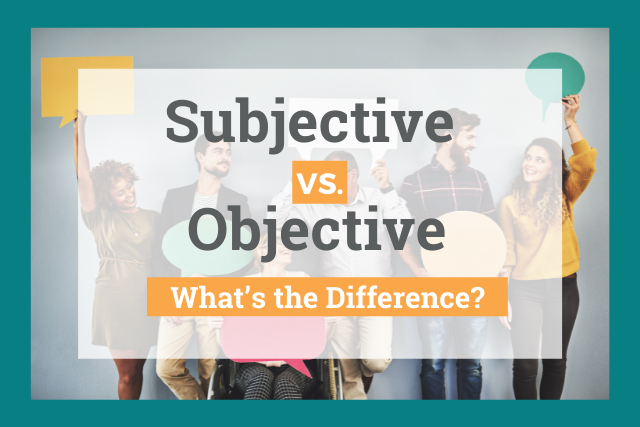
If you’re trying to write a strong essay or story, it’s often important to understand the difference between subjective and objective truth.
What exactly do the words subjective and objective mean, and when should you use each?
This article will explain the difference between the two words, provide examples of how they’re used in a sentence, and discuss whether you should look for objective or subjective information to support your own writing.
- What’s the Difference Between Subjective vs. Objective?
How Would You Use Objective and Subjective in a Sentence?
What are some examples of objective statements, what are some examples of subjective information, how can you tell if something is objective or subjective, what is an objective opinion, are impartial facts better than personal feelings, what’s the difference between subjective vs. objective .
The difference between objective and subjective is related to the difference between facts and opinions.
The word objective describes information that’s based on verifiable facts. Objective truth can be verified by a third party, regardless of who the third party is.
For example, the sentence “The temperature outside is around 10°C” is an objective statement, because that statement will be equally true no matter who says it. Anybody in the world with a working thermometer could verify this statement.
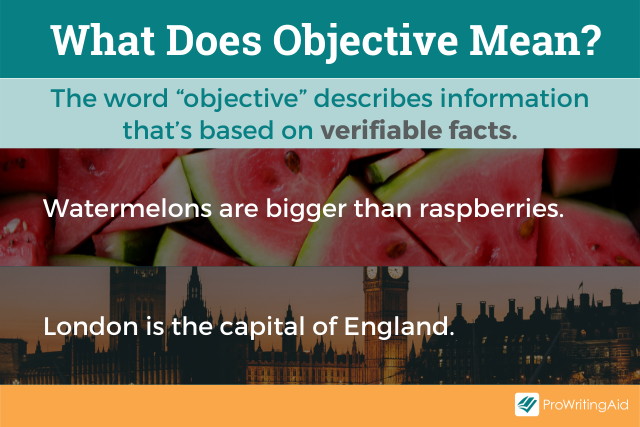
The word subjective is the exact opposite; it describes information that’s based on personal opinion or personal interpretation.
Subjective truth might be different for different people, depending on their own tastes, preferences, or experiences.
The sentence “It’s very cold outside” is a subjective statement, because how true this sentence is depends on personal opinions and experiences.
Many temperatures would feel very cold to someone who grew up in Arizona, but comfortably warm to someone who grew up in Alaska.
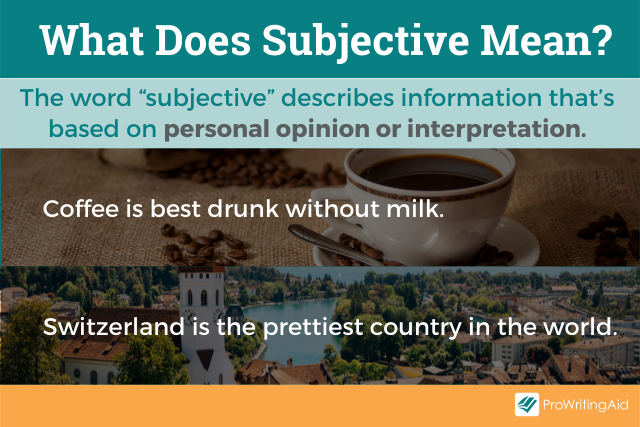
One easy way to remember the difference between the two words is to remember that “objective” sounds like “object.”
Objective facts are as concrete as the objects you can touch, like your desk, your bike, or your water bottle.
Subjective facts, on the other hand, pertain to more abstract concepts, like beauty, joy, or discomfort.
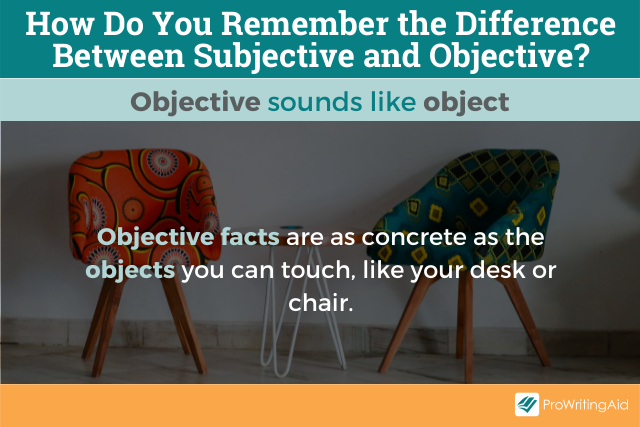
Here’s an example of a sentence that uses both objective and subjective in context:
"But now we, as pathologists, need more objective measures because symptoms, to a certain degree, are subjective ." (Time)
This sentence, a quote from a pathologist, argues that symptoms of diseases are somewhat subjective because they differ from person to person.
One patient with the flu might feel horribly nauseous, while another patient with the same flu might feel only a mild cough.
As a result, it’s useful for doctors to have objective tools to determine how ill people are, which don’t have results that vary from person to person.
That way, they can track the way a disease spreads even if not all patients feel the same symptoms.
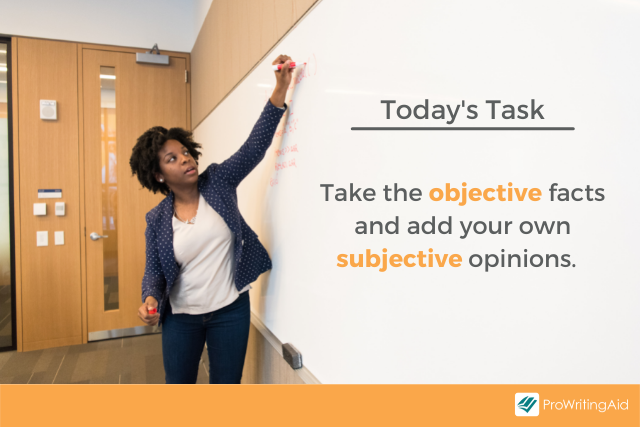
Let’s look at another example.
"We take our unruly, subjective feelings about a year of television and groom them into something that looks mathematical and objective ." (Slate)
This sentence, a quote from a TV critic, argues that trying to rank TV shows is a meaningless task.
Every viewer has different tastes; some might love lighthearted sitcoms, while others prefer serious dramas.
There’s no objective way for a TV critic to determine a Top 10 list that applies to everybody, because everyone’s tastes and enjoyment levels are inherently subjective.
If what you’re writing can be proven or disproven by evidence, it’s an objective statement. Likewise, if you include a reference to an study or an experiment, it is an objective statement.
Remember to always reference information like this. ProWritingAid’s Plagiarism Checker can ensure that you never inadvertently pass off someone else’s work as your own.
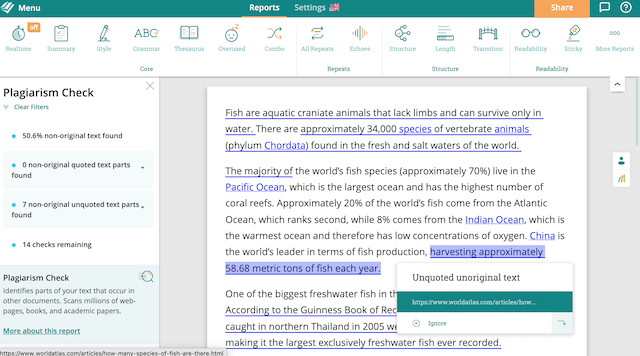
Find out more about Plagiarism Checks.
Here are some examples of objective information:
- The largest freshwater fish ever caught was 646 pounds. (Cite- Brittanica)
- Abraham Lincoln was the sixteenth president of the United States.
- The World Health Organization declared COVID-19 a pandemic on March 11, 2020.
- I have eaten the plums that were in the icebox.
Keep in mind that those statements would still be considered objective even if they were false.
It’s a common mistake to assume that “objective” is synonymous with “true,” but lies can be objective statements, too. The statement remains objective as long as it doesn’t depend on feelings or opinions.
For example, if William Carlos Williams had written “I didn’t eat any of the plums that were in the icebox,” even though he actually did, that would still qualify as an objective statement.
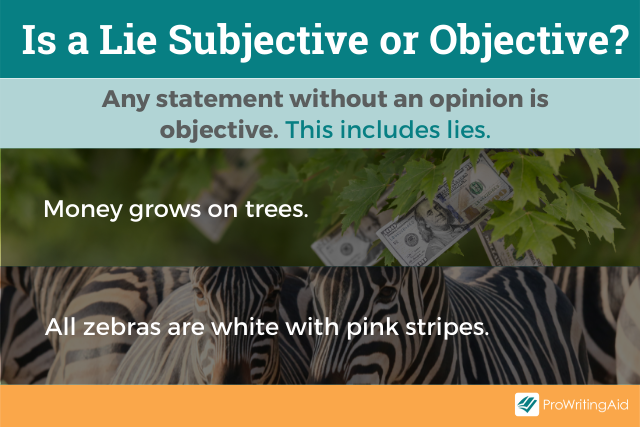
Here are some examples of false objective statements:
- Abraham Lincoln was the first president of the United States.
- The World Health Organization has never issued an official statement about COVID-19.
- I didn’t eat any of the plums that were in the icebox.
If a statement relies on personal feelings or beliefs, it’s likely to be subjective.
Here are some examples of subjective statements:
- It feels very warm outside.
- Dogs are better than cats.
- The plums in the icebox tasted delicious.
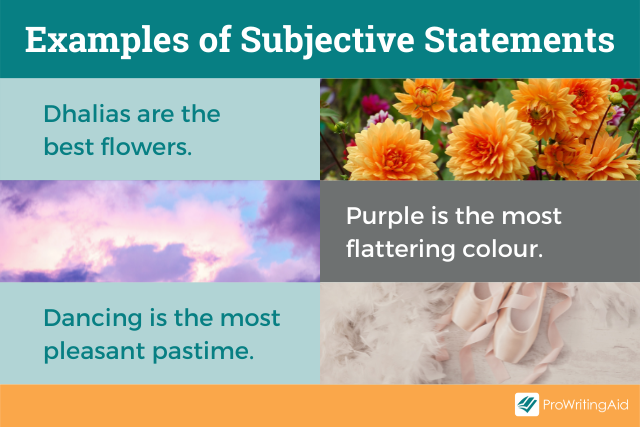
Watch out for subjective information that’s disguised as objective analysis. For example, a newspaper headline that says “New Study Shows That Dogs Are 85% Better Than Cats” sounds like an objective fact. However, because it depends on personal preferences and opinions, it’s still a subjective statement.
Here are some subjective statements that are disguised to sound like objective statements:
- It is objectively very warm outside.
- A new study shows that dogs are 85% better than cats.
- Plums in iceboxes taste ten times better than plums that are left in the heat.
If you’re not sure whether a statement is objective or subjective, here are some useful questions you can ask yourself.
To determine whether a statement is objective , ask:
- Is this statement based on factual evidence?
- Is there a way a scientist could test this statement to figure out if it’s true or false?
- Would a robot without any concept of human emotion be able to say this statement?
If the answers to any of the above questions are “yes,” you’re probably dealing with an objective statement.
To determine whether a statement is subjective , ask:
- Is this statement based on someone’s feelings, preferences, or personal tastes?
- Is it impossible to determine whether this statement is true or false?
- Does this statement make a judgement about something (e.g. good or bad, right or wrong, beautiful or ugly)?
If the answers to any of the above questions are “yes,” you’re probably dealing with a subjective statement.
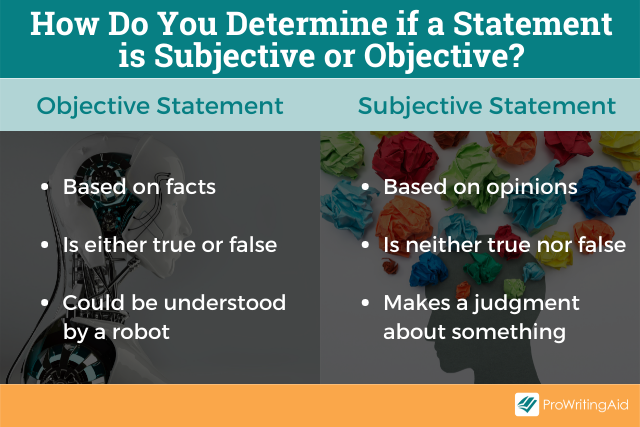
You can also look at the source of the statement to help you figure out how objective it is.
Sources like peer-reviewed scientific articles and unbiased news articles tend to contain more objective material.
Sources like opinion pieces and creative non-fiction tend to contain more subjective material.
The phrase "objective opinion" might seem counterintuitive, since these two words are essentially opposites.
In this context, the word "objective" means unbiased and impartial, rather than factual. This is also true for the phrase "objective assessment."
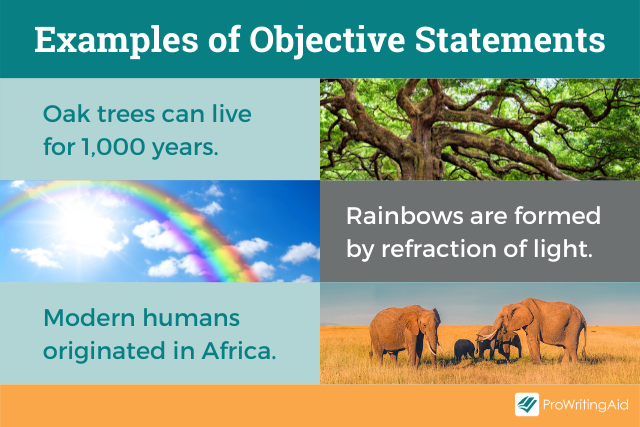
For example, you might ask a friend for an objective opinion about whether or not you should break up with your boyfriend.
In this scenario, your friend can’t give you objective advice if they have a personal reason for wanting you to make this decision, such as if they’re secretly in love with your boyfriend too.
Whether you should use subjective or objective statements depends on what your goal is.
If you’re writing a persuasive essay, you’ll usually need factual or quantitative data to make your writing credible. It’s important to search for objective facts from a reliable and impartial source.
On the other hand, you can also make use of subjective evidence, such as personal anecdotes. If you’re writing a persuasive essay about why bullying is wrong, a heartfelt story from the perspective of someone who’s been bullied might touch more readers than impersonal facts.
Most strong essays make use of both subjective and objective truth.
Final Words on the Difference Between Subjective vs. Objective
There you have it: a comprehensive guide to the difference between subjective and objective statements. Which examples did you find most helpful? Let us know in the comments.
Now is a wonderful time to be a copywriter. Download this free book to learn how:
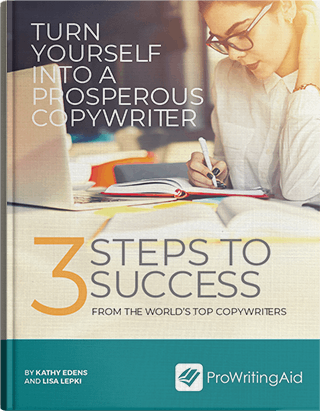
Turn Yourself Into a Prosperous Copywriter
With the advent of the internet, the copywriting industry is exploding. content is now seen as critical for all online businesses., this guide breaks down the three essential steps you must take if you think copywriting is the career for you..

Be confident about grammar
Check every email, essay, or story for grammar mistakes. Fix them before you press send.
Hannah Yang is a speculative fiction writer who writes about all things strange and surreal. Her work has appeared in Analog Science Fiction, Apex Magazine, The Dark, and elsewhere, and two of her stories have been finalists for the Locus Award. Her favorite hobbies include watercolor painting, playing guitar, and rock climbing. You can follow her work on hannahyang.com, or subscribe to her newsletter for publication updates.
Get started with ProWritingAid
Drop us a line or let's stay in touch via :
- Link to facebook
- Link to linkedin
- Link to twitter
- Link to youtube
- Writing Tips
6 Tips on Achieving an Objective Tone in Writing

- 5-minute read
- 11th July 2021
An objective tone is standard in most formal business and academic writing. But how can you make your writing sound objective? Our top tips include:
- Try to avoid unnecessary use of the first person and first-person pronouns.
- Focus on facts and cite sources clearly to back up your claims.
- Aim for balance and consider multiple perspectives.
- Beware of emotive language that betrays a subjective opinion.
- Use a formal writing style throughout.
- Have your writing proofread to make sure it is always error-free.
For more detail on how to achieve an objective tone in writing, read on.
1. Try Not to Use the First Person
Objective writing aims for a neutral, impersonal tone. As such, you should try to minimise the use of the first person and first-person pronouns such as ‘I’, ‘me’ and ‘mine’, which put too much focus on you as the writer of the document.
One option is to use the passive voice more. For instance:
I will outline the main arguments. -> The main arguments will be outlined.
However, this can sound awkward or leave your writing unclear (e.g. the sentence above does not specify who or what will outline the arguments). As such, it is often better to stick to the active voice and use the third person instead. For example:
This paper will outline the main arguments.
Here, the meaning is clear, but we avoid using any first-person pronouns.
2. Focus on Facts and Data
Objective writing should be clear and factual. As such, you will need to:
- Research your topic extensively – Before you start writing, make sure to research the topic in detail so you are clear on the facts.
- Always cite your sources – Citing sources adds credibility to your writing by showing your reader where your information came from.
- Consider your sources – Where you get information from matters. Your sources should be unbiased, especially in academic writing. Before citing something or quoting a fact, then, make sure it is from a trustworthy source .
If you can back up your claims with well-researched facts, your writing will come across as much more objective than if you simply make unsupported claims.
3. Be Fair and Balanced
If you present only one side of an argument in your writing, it could appear biased and lose credibility. To achieve an objective tone, then, you must show balance. And this means sharing different viewpoints and perspectives.
Find this useful?
Subscribe to our newsletter and get writing tips from our editors straight to your inbox.
This is especially important if you are presenting an argument in academic writing where acknowledging potential counterarguments or competing points of view is a key part of testing the strength of your position. But it also applies to business writing, where considering multiple perspectives provides important context and shows that you have researched the issue thoroughly.
You don’t always have to give every opinion equal weight or present every possible argument, though, or you run the risk of overwhelming the reader with too much information. Instead, focus on the key perspectives in the subject area.
4. Avoid Emotive Language
Typically, objective writing should avoid emotive language or words that suggest a subjective opinion. For example:
Smith (2020) offers a brilliantly clever solution to this terrible problem.
Here, the words ‘brilliantly clever’ and ‘terrible’ don’t add anything substantive to the sentence. Rather, they signal something about the author’s opinion. And by adding this kind of emotive language, we prompt the reader to respond in a particular way (e.g. to see the solution as ‘brilliantly clever’).
This is not to say you should never offer an opinion in objective writing (e.g. you may need to weigh the benefits of certain actions and recommend the best option to meet a specific objective, which will inevitably involve an element of opinion). But you should present your opinions in a neutral tone and back them up with facts, not relying on emotive or otherwise subjective language to influence your reader.
5. Keep Your Writing Formal
As well as the subjective and emotive language discussed so far, objective writing should avoid informal and colloquial language. This includes:
- Using standard spelling and grammar throughout.
- Avoiding contractions (e.g. instead of using ‘can’t’, use ‘cannot’).
- Cutting out all slang and informal figures of speech.
- Using the correct technical language for your subject area.
This formal style is common in business and academic writing as it reduces the strength of the individual’s voice and thus contributes to an objective tone.
6. Have Your Work Proofread
Errors in writing suggest a lack of care or attention to detail (even when this isn’t true). To make sure your documents have a truly objective, authoritative tone, then, it pays to get them proofread by the writing experts.
Our editors are available 24/7, all year round, so we are always here to help. You can even try our services for free ! Get in touch today to find out more.
Share this article:
Post A New Comment
Get help from a language expert. Try our proofreading services for free.
3-minute read
What Is a Content Editor?
Are you interested in learning more about the role of a content editor and the...
4-minute read
The Benefits of Using an Online Proofreading Service
Proofreading is important to ensure your writing is clear and concise for your readers. Whether...
2-minute read
6 Online AI Presentation Maker Tools
Creating presentations can be time-consuming and frustrating. Trying to construct a visually appealing and informative...
What Is Market Research?
No matter your industry, conducting market research helps you keep up to date with shifting...
8 Press Release Distribution Services for Your Business
In a world where you need to stand out, press releases are key to being...
How to Get a Patent
In the United States, the US Patent and Trademarks Office issues patents. In the United...

Make sure your writing is the best it can be with our expert English proofreading and editing.
- Food & Dining
- Coronavirus
- Real Estate
- Seattle History
- PNW Politics
How to Write Objectives in Papers
- College & Higher Education
Related Articles
Teacher tips: how to write thesis statements for high school papers, how to write an essay in conversational style, eight critical thinking guidelines in psychology.
- Importance of Doing an Outline Prior to Writing
- How to Write a Five-Sentence Paragraph in Middle School
The objective of the paper is the reason given for writing the paper. By stating your objective, you’re telling the reader exactly what you’re hoping to demonstrate, and exactly what they can hope to learn -- or be convinced of. The objective of a paper is often called a thesis statement, and it needs to be right up front and center in your paper -- if you write it well, and give it pride of place in your introduction, then it should give strong support to the rest of your paper.
When you’re writing an academic paper, it can be tempting to be verbose. Many students think that they’ll sound smart if they’re wordy. But there’s nothing smart about using ten words when you could use one word, or about using a ten-letter word when you could use a five-letter word. Confused readers are frustrated readers, not admiring readers. While it’s always important to use clear language when you’re writing an academic paper, this is especially true of the objective. If the reader can’t understand the point of the paper, there will be no reason for them to read further.
Remember that the objective is the purpose of the entire paper, not the entire paper itself. Don’t try to cram all of your research, sources, and evidence into one or two sentences. The objectives should reflect the main thrust of your paper, not delve into the nitty gritty details. Keeping your objectives short doesn’t mean selling them short: it means taking a bird’s eye-view of your paper and expressing the most important general principles concisely.
Be Interesting
“Objective” is a dry word, but if there’s one thing the objective of a paper should be, it’s interesting. If the objective of a paper is boring, you can bet that the paper is boring. Students often think that professors don’t care if a paper is interesting, but professors are like any other reader -- they want to be pulled into a paper, not bored to death by it. Make sure that your language is vivid and captures your reader’s attention.
Prove That You’re Going to Prove Something
It won’t matter how clear your objective is, how brief it is, or even how interesting it is, unless it convinces the reader that you’ll convince them of something. (Or, if not, convinces them that you’ll convince them of something, then at least convinces them that you’ll present a compelling argument.) The point of your paper is always to prove something, whether it’s that global warming is a real thing or that Shakespeare’s plays weren’t all they were cracked up to be.
- Columbia University: How to Write Your Thesis
Living in Canada, Andrew Aarons has been writing professionally since 2003. He holds a Bachelor of Arts in English literature from the University of Ottawa, where he served as a writer and editor for the university newspaper. Aarons is also a certified computer-support technician.
Rules for Thesis Statements
What are the four tips for writing a good thesis statement for an expository essay, attention grabbers to use when writing an essay, how to write an essay that stands out, how to write a college expository essay, what problems take place when choosing research topics & research questions, how to write a higher level essay introduction, how to assess the strength or weakness of a thesis statement, fifth grade writing ideas: creative ways to begin sentences, most popular.
- 1 Rules for Thesis Statements
- 2 What Are the Four Tips for Writing a Good Thesis Statement for an Expository Essay?
- 3 Attention Grabbers to Use When Writing an Essay
- 4 How to Write an Essay That Stands Out


How to Write Objectives | A Step-to-step Guide (2023)
Astrid Tran • 31 Aug 2023 • 6 min read
Objectives are needed for every aspect of life, work and education.
Whether you are setting objectives for academic research, teaching and learning, courses and training, personal development, professional growth, a project, or more, having clear objectives like having a compass to help you stay on track.
So, how to write objectives? Check out this article to get a complete guide on writing realistic and impactful objectives.
Table of Contents
How to write objectives of a project
How to write objectives for a presentation, how to write objectives for lesson plan, how to write objectives for a research, how to write objectives for personal growth.
More tips on how to write objectives
Frequently Asked Questions
Project objectives often focus on tangible results, such as completing specific tasks, delivering products, or achieving certain milestones within a defined timeframe.
Writing project objectives should follow these principles:
Start early : It is important to set your project objectives at the beginning of your project to avoid unexpected situations and employees misunderstanding.
Changes : Project objectives can be determined to address challenges of previous projects experience and seek to minimize potential risks prior to the project begins.
Achievement : An objective of a project should mention what success is. Different success is measured by specific and measurable objectives.
OKR : OKR stands for “objectives and key results,” a managerial model that aims to set goals and identify metrics to measure progress. Objectives are your destination, while key results contribute to the path that will get you there.
Focus : Different project objectives might consist of related issues such as:
- Customer satisfaction
- Turnover and Retention
- Sales and Revenue
- Return on investment (ROI)
- Sustainability
- Productivity
For example :
- The goal of the campaign is to improve the traffic by 15% before the end of the first quarter.
- This project aims to produce 5,000 units of products in the next three months.
- Add five new methods for clients to seek the feedback form in-product within the next three months.
- Increase click through rate (CTR) engagement on email by 20% by the end of the second quarter.

Presentation objectives outline what you intend to accomplish with your presentation, which might involve informing, persuading, educating, or inspiring your audience. They guide the content creation process and shape how you engage your listeners during the presentation.
When it comes to writing presentation objectives, there are some notes to look at:
The questions “Why” : To write a good presentation objective, start with answering why questions, such as Why is this presentation important to your audience? Why should people invest time and money to attend this presentation? Why is your content important to the organization?
What do you want the audience to know, feel and do ? Another important of writing objectives for a presentation is considering the comprehensive impact your presentation has on the audience. This pertains to the informational, emotional, and actionable aspect.
Rule of three : When you write your objectives in your PPT, don’t forget to express no more than three key points per slide.
Some examples of objectives:
- Ensure the managers understand that without additional funding of $10,000, the project will fail.
- Get commitment from the director of sales to a three-tier pricing proposal for customer Prime.
- Get the audience to commit to reducing their personal plastic usage by signing a pledge to avoid single-use plastics for at least a week.
- Participants will feel empowered and confident about managing their finances, replacing financial anxiety with a sense of control and informed decision-making.

Get your Students Engaged
Start meaningful discussion, get useful feedback and educate your students. Sign up to take free AhaSlides template
Learning objectives, often used in education and training, specify what learners are expected to gain from a learning experience. These objectives are written to guide curriculum development, instructional design, and assessment.
A guide on writing an objective for learning and lesson plan described as follows:
Learning objectives verbs : There is no better way to have learning objectives start with measurable verbs collected by Benjamin Bloom based on level of cognition.
- Knowledge level: tell, uncover, show, state, define, name, write, recall,…
- Comprehension level: indicate, illustrate, represent, formulate, explain, classify, translate,…
- Application level: perform, make a chart, put into action, build, report, employ, draw, adapt, apply,…
- Analysis Level: analyze, study, combine, separate, categorize, detect, examine,…
- Synthesis Level: integrate, conclude, adapt, compose, construct, create, design,…
- Evaluation Level: evaluate, interpret, decide, solve, rate, appraise, verify,…
Student-centered : Objectives should reflect the unique aspirations, strengths and weaknesses of each student, emphasize what students will know or be able to do, not what you will teach or cover.
Learning Objective Examples:
- To recognize the power of different types of language
- By the end of this course, students will be able to identify and develop data collection instruments and measures for planning and conducting sociological research.
- By the end of this course, students will be able to identify their own position on the political spectrum.

The purpose of research objectives is congruent with research study outcomes.They articulate the purpose of the research, what the researcher intends to investigate, and the expected outcomes.
There are severals principles to follow to ensure a well-written research objectives:
Academic language : It is important to note that research writing is strict on the use of language. It is held to a high standard of clarity, precision, and formality.
Avoid using first-person references to state the objectives. Replace “I will” with neutral phrasing that emphasizes the research’s intention. Avoid emotional language, personal opinions, or subjective judgments.
Pinpoint the Focus : Your research objectives should clearly articulate what your study aims to investigate, analyze, or uncover.
Specify the Scope : Outline the boundaries of your research by specifying the scope. Clearly delineate what aspects or variables will be examined, and what will not be addressed.
Maintain Consistency with Research Questions : Ensure your research objectives align with your research questions.
Frequently used phrases in research objectives
- …contribute to the knowledge of…
- …search for…
- Our study will also document….
- The primary objective is to integrate…
- The purposes of this research include:
- We attempt to…
- We formulated these objective based on
- This study searches for
- The second gold is to test
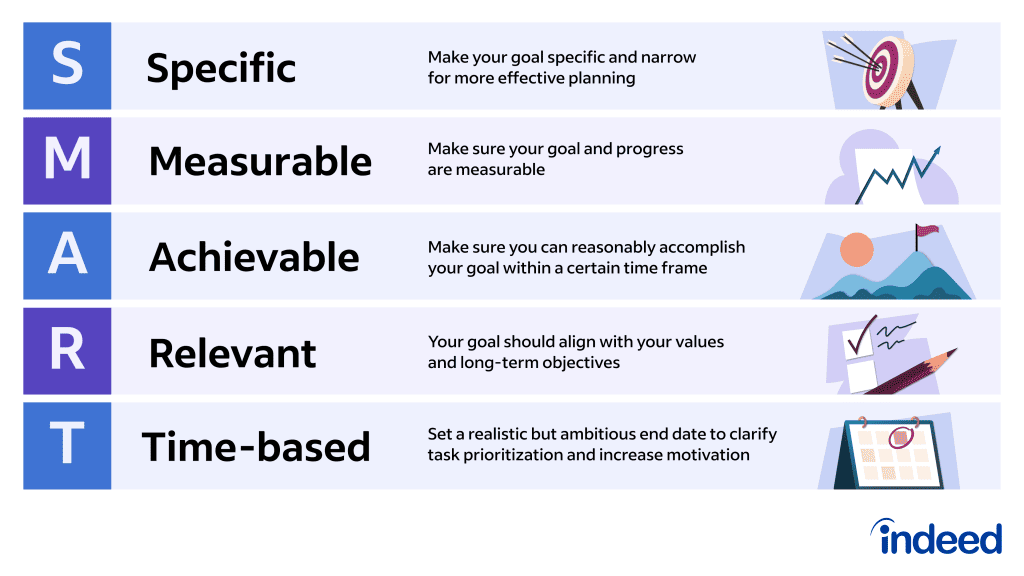
Objectives for personal growth often focus on individual improvement on skills, knowledge, well-being, and overall development.
Personal growth objectives encompass various aspects of life, including emotional, intellectual, physical, and interpersonal dimensions. They serve as roadmaps for continuous learning, growth, and self-awareness.
- Read one non-fiction book each month to expand knowledge in areas of personal interest.
- Incorporate regular exercise into the routine by walking or jogging for at least 30 minutes five times a week.
Tips to write objectives for personal growth from AhaSlides.
💡 Development Goals For Work: A Step-By-Step Guide For Beginners with Examples
💡 What is Personal Growth? Set Up Personal Goals For Work | Updated in 2023
💡 Work Goals Examples For Evaluation with +5 Steps To Create in 2023
How to write objectives in general? Here are common tips for setting objectives of any field.
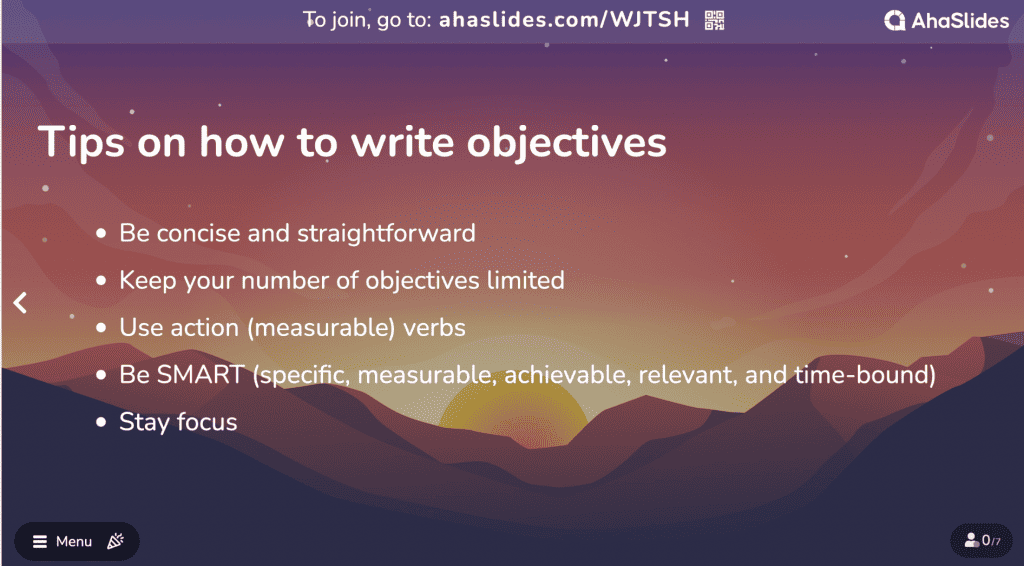
#1. Be concise and straightforward
Keep the words as simple and straightforward as much as possible. It is much better to remove unnecessary or ambiguous words that might lead to misunderstanding.
#2. Keep your number of objectives limited
Don’t confuse your learners or readers with too many objectives. Concentrating on a few key objectives can effectively maintain focus and clarity and prevent overwhelming.
#3. Use action verbs
You can start each objective with one of the following measurable verbs: Describe, Explain, Identify, Discuss, Compare, Define, Differentiate, List, and more.
#4. Be SMART
SMART objectives framework can be defined with specific, measurable, achievable, relevant, and time-bound. These objectives are clearer and easier to understand and achieve.
⭐ Want more inspiration? Check out AhaSlides to explore the innovative way to get presentations and lesson engaging and fun!
What are the 3 parts of an objective?
According to Mager (1997), objective statements contain three parts: behavior (or, performance), conditions, and criteria.
What are the 4 elements of a well-written objective?
The four elements of an objective are Audience, Behavior, Condition, and Degree, called A-B-C-D method. They are used to identify what a student is expected to know and how to test them.
What are the 4 components of objective writing?
There are four components of an objective include: (1) the action verb, (2) conditions, (3) standard, and (4) the intended audience (always the students)
Ref: Indeed | Batchwood |

Astrid Tran
I've got my rhythm with words
More from AhaSlides

- If you are writing in a new discipline, you should always make sure to ask about conventions and expectations for introductions, just as you would for any other aspect of the essay. For example, while it may be acceptable to write a two-paragraph (or longer) introduction for your papers in some courses, instructors in other disciplines, such as those in some Government courses, may expect a shorter introduction that includes a preview of the argument that will follow.
- In some disciplines (Government, Economics, and others), it’s common to offer an overview in the introduction of what points you will make in your essay. In other disciplines, you will not be expected to provide this overview in your introduction.
- Avoid writing a very general opening sentence. While it may be true that “Since the dawn of time, people have been telling love stories,” it won’t help you explain what’s interesting about your topic.
- Avoid writing a “funnel” introduction in which you begin with a very broad statement about a topic and move to a narrow statement about that topic. Broad generalizations about a topic will not add to your readers’ understanding of your specific essay topic.
- Avoid beginning with a dictionary definition of a term or concept you will be writing about. If the concept is complicated or unfamiliar to your readers, you will need to define it in detail later in your essay. If it’s not complicated, you can assume your readers already know the definition.
- Avoid offering too much detail in your introduction that a reader could better understand later in the paper.
- picture_as_pdf Introductions
Have a language expert improve your writing
Run a free plagiarism check in 10 minutes, generate accurate citations for free.
- Knowledge Base
- How to write an argumentative essay | Examples & tips
How to Write an Argumentative Essay | Examples & Tips
Published on July 24, 2020 by Jack Caulfield . Revised on July 23, 2023.
An argumentative essay expresses an extended argument for a particular thesis statement . The author takes a clearly defined stance on their subject and builds up an evidence-based case for it.
Instantly correct all language mistakes in your text
Upload your document to correct all your mistakes in minutes

Table of contents
When do you write an argumentative essay, approaches to argumentative essays, introducing your argument, the body: developing your argument, concluding your argument, other interesting articles, frequently asked questions about argumentative essays.
You might be assigned an argumentative essay as a writing exercise in high school or in a composition class. The prompt will often ask you to argue for one of two positions, and may include terms like “argue” or “argument.” It will frequently take the form of a question.
The prompt may also be more open-ended in terms of the possible arguments you could make.
Argumentative writing at college level
At university, the vast majority of essays or papers you write will involve some form of argumentation. For example, both rhetorical analysis and literary analysis essays involve making arguments about texts.
In this context, you won’t necessarily be told to write an argumentative essay—but making an evidence-based argument is an essential goal of most academic writing, and this should be your default approach unless you’re told otherwise.
Examples of argumentative essay prompts
At a university level, all the prompts below imply an argumentative essay as the appropriate response.
Your research should lead you to develop a specific position on the topic. The essay then argues for that position and aims to convince the reader by presenting your evidence, evaluation and analysis.
- Don’t just list all the effects you can think of.
- Do develop a focused argument about the overall effect and why it matters, backed up by evidence from sources.
- Don’t just provide a selection of data on the measures’ effectiveness.
- Do build up your own argument about which kinds of measures have been most or least effective, and why.
- Don’t just analyze a random selection of doppelgänger characters.
- Do form an argument about specific texts, comparing and contrasting how they express their thematic concerns through doppelgänger characters.
Prevent plagiarism. Run a free check.
An argumentative essay should be objective in its approach; your arguments should rely on logic and evidence, not on exaggeration or appeals to emotion.
There are many possible approaches to argumentative essays, but there are two common models that can help you start outlining your arguments: The Toulmin model and the Rogerian model.
Toulmin arguments
The Toulmin model consists of four steps, which may be repeated as many times as necessary for the argument:
- Make a claim
- Provide the grounds (evidence) for the claim
- Explain the warrant (how the grounds support the claim)
- Discuss possible rebuttals to the claim, identifying the limits of the argument and showing that you have considered alternative perspectives
The Toulmin model is a common approach in academic essays. You don’t have to use these specific terms (grounds, warrants, rebuttals), but establishing a clear connection between your claims and the evidence supporting them is crucial in an argumentative essay.
Say you’re making an argument about the effectiveness of workplace anti-discrimination measures. You might:
- Claim that unconscious bias training does not have the desired results, and resources would be better spent on other approaches
- Cite data to support your claim
- Explain how the data indicates that the method is ineffective
- Anticipate objections to your claim based on other data, indicating whether these objections are valid, and if not, why not.
Rogerian arguments
The Rogerian model also consists of four steps you might repeat throughout your essay:
- Discuss what the opposing position gets right and why people might hold this position
- Highlight the problems with this position
- Present your own position , showing how it addresses these problems
- Suggest a possible compromise —what elements of your position would proponents of the opposing position benefit from adopting?
This model builds up a clear picture of both sides of an argument and seeks a compromise. It is particularly useful when people tend to disagree strongly on the issue discussed, allowing you to approach opposing arguments in good faith.
Say you want to argue that the internet has had a positive impact on education. You might:
- Acknowledge that students rely too much on websites like Wikipedia
- Argue that teachers view Wikipedia as more unreliable than it really is
- Suggest that Wikipedia’s system of citations can actually teach students about referencing
- Suggest critical engagement with Wikipedia as a possible assignment for teachers who are skeptical of its usefulness.
You don’t necessarily have to pick one of these models—you may even use elements of both in different parts of your essay—but it’s worth considering them if you struggle to structure your arguments.
Regardless of which approach you take, your essay should always be structured using an introduction , a body , and a conclusion .
Like other academic essays, an argumentative essay begins with an introduction . The introduction serves to capture the reader’s interest, provide background information, present your thesis statement , and (in longer essays) to summarize the structure of the body.
Hover over different parts of the example below to see how a typical introduction works.
The spread of the internet has had a world-changing effect, not least on the world of education. The use of the internet in academic contexts is on the rise, and its role in learning is hotly debated. For many teachers who did not grow up with this technology, its effects seem alarming and potentially harmful. This concern, while understandable, is misguided. The negatives of internet use are outweighed by its critical benefits for students and educators—as a uniquely comprehensive and accessible information source; a means of exposure to and engagement with different perspectives; and a highly flexible learning environment.
The body of an argumentative essay is where you develop your arguments in detail. Here you’ll present evidence, analysis, and reasoning to convince the reader that your thesis statement is true.
In the standard five-paragraph format for short essays, the body takes up three of your five paragraphs. In longer essays, it will be more paragraphs, and might be divided into sections with headings.
Each paragraph covers its own topic, introduced with a topic sentence . Each of these topics must contribute to your overall argument; don’t include irrelevant information.
This example paragraph takes a Rogerian approach: It first acknowledges the merits of the opposing position and then highlights problems with that position.
Hover over different parts of the example to see how a body paragraph is constructed.
A common frustration for teachers is students’ use of Wikipedia as a source in their writing. Its prevalence among students is not exaggerated; a survey found that the vast majority of the students surveyed used Wikipedia (Head & Eisenberg, 2010). An article in The Guardian stresses a common objection to its use: “a reliance on Wikipedia can discourage students from engaging with genuine academic writing” (Coomer, 2013). Teachers are clearly not mistaken in viewing Wikipedia usage as ubiquitous among their students; but the claim that it discourages engagement with academic sources requires further investigation. This point is treated as self-evident by many teachers, but Wikipedia itself explicitly encourages students to look into other sources. Its articles often provide references to academic publications and include warning notes where citations are missing; the site’s own guidelines for research make clear that it should be used as a starting point, emphasizing that users should always “read the references and check whether they really do support what the article says” (“Wikipedia:Researching with Wikipedia,” 2020). Indeed, for many students, Wikipedia is their first encounter with the concepts of citation and referencing. The use of Wikipedia therefore has a positive side that merits deeper consideration than it often receives.
Here's why students love Scribbr's proofreading services
Discover proofreading & editing
An argumentative essay ends with a conclusion that summarizes and reflects on the arguments made in the body.
No new arguments or evidence appear here, but in longer essays you may discuss the strengths and weaknesses of your argument and suggest topics for future research. In all conclusions, you should stress the relevance and importance of your argument.
Hover over the following example to see the typical elements of a conclusion.
The internet has had a major positive impact on the world of education; occasional pitfalls aside, its value is evident in numerous applications. The future of teaching lies in the possibilities the internet opens up for communication, research, and interactivity. As the popularity of distance learning shows, students value the flexibility and accessibility offered by digital education, and educators should fully embrace these advantages. The internet’s dangers, real and imaginary, have been documented exhaustively by skeptics, but the internet is here to stay; it is time to focus seriously on its potential for good.
If you want to know more about AI tools , college essays , or fallacies make sure to check out some of our other articles with explanations and examples or go directly to our tools!
- Ad hominem fallacy
- Post hoc fallacy
- Appeal to authority fallacy
- False cause fallacy
- Sunk cost fallacy
College essays
- Choosing Essay Topic
- Write a College Essay
- Write a Diversity Essay
- College Essay Format & Structure
- Comparing and Contrasting in an Essay
(AI) Tools
- Grammar Checker
- Paraphrasing Tool
- Text Summarizer
- AI Detector
- Plagiarism Checker
- Citation Generator
An argumentative essay tends to be a longer essay involving independent research, and aims to make an original argument about a topic. Its thesis statement makes a contentious claim that must be supported in an objective, evidence-based way.
An expository essay also aims to be objective, but it doesn’t have to make an original argument. Rather, it aims to explain something (e.g., a process or idea) in a clear, concise way. Expository essays are often shorter assignments and rely less on research.
At college level, you must properly cite your sources in all essays , research papers , and other academic texts (except exams and in-class exercises).
Add a citation whenever you quote , paraphrase , or summarize information or ideas from a source. You should also give full source details in a bibliography or reference list at the end of your text.
The exact format of your citations depends on which citation style you are instructed to use. The most common styles are APA , MLA , and Chicago .
The majority of the essays written at university are some sort of argumentative essay . Unless otherwise specified, you can assume that the goal of any essay you’re asked to write is argumentative: To convince the reader of your position using evidence and reasoning.
In composition classes you might be given assignments that specifically test your ability to write an argumentative essay. Look out for prompts including instructions like “argue,” “assess,” or “discuss” to see if this is the goal.
Cite this Scribbr article
If you want to cite this source, you can copy and paste the citation or click the “Cite this Scribbr article” button to automatically add the citation to our free Citation Generator.
Caulfield, J. (2023, July 23). How to Write an Argumentative Essay | Examples & Tips. Scribbr. Retrieved April 8, 2024, from https://www.scribbr.com/academic-essay/argumentative-essay/
Is this article helpful?

Jack Caulfield
Other students also liked, how to write a thesis statement | 4 steps & examples, how to write topic sentences | 4 steps, examples & purpose, how to write an expository essay, unlimited academic ai-proofreading.
✔ Document error-free in 5minutes ✔ Unlimited document corrections ✔ Specialized in correcting academic texts

- Walden University
- Faculty Portal
Writing a Paper: How to Set a Writing Goal
How to set a writing goal.
Strong written communication consistently ranks among employers’ top desired skills. It is a skill that traverses disciplines, as most professionals need to know how to communicate clearly in writing. Yet knowing where to start building your written communication skills can be challenging. We recommend starting with setting clear writing goals. The following resources will guide you in forming clear, actionable writing goals.
Getting Started
The first step in setting a writing goal is getting to know yourself as a writer. What are your strengths and improvement areas as a writer? What stresses you out about writing? What is your typical writing routine, and are there ways to improve that process? To answer these questions, you may consider the following steps:
- Take stock of your writing experiences—past and present—and reflect on what you know about your writing abilities and learning style
- Sketch out your existing writing practice (i.e., where, when, and how you write) and pinpoint distractions (e.g., social media, noisy workspace , lateness in the day )
- Outline your ideal writing process (i.e., if everything in your writing process worked out perfectly with no distractions) and highlight potential skills or techniques to model
- Learn from other writers and explore what practices they have employed to keep the writing process running smoothly
- Identify personal obstacles to your writing process —whether it be your own self-consciousness or the blank page—and assess ways to alleviate these pressures
Once you have this information, ask yourself: What did I learn about myself as a writer, what specific patterns or practices in my writing or writing process would I like to change, and what steps do I need to take in order to develop those skills? You can use your responses to start setting writing-specific goals.
Drafting Writing-Specific Goals
At this point, you may be asking yourself: What is a writing-specific goal and how do I set one? Let's start with what a writing goal is.
A writing goal is an objective you set to build on and enhance a particular skill or set of skills that influence your writing. Writing goals, in this regard, are about identifying skills in your writing or patterns in your writing process that need growth and development.
You may find that, based on what you learned about yourself as a writer in the “Getting Started” section, your writing goals are related to mastering APA citations and references or establishing a better method for organizing ideas or improving your knowledge of academic writing and its impact on tone. This list is a quick preview of possible goals; however, there are countless, other writing-specific goals to consider, including but not limited to clarity, cohesion, flow, analysis, synthesis, paraphrasing, and grammar skills. Each of these areas is an excellent basis for establishing a writing goal.
The next step is to use SMART Goal Criteria to ensure your goal can be realistically achieved.
Using SMART Goals as a Guide
The SMART Goals Guide is an excellent tool for ensuring you set clear, manageable writing goals. It helps to establish that your writing goals are:
S–Specific: Is your goal focused and specific? Does it avoid generalizations and abstractions?
M–Measureable: Can you track your progress and completion? What indicators will you use?
A–Achievable: Is this goal within your control? Do you have the necessary resources for success?
R–Relevant: How does this goal impact your skills set and where you want to be?
T–Timely: Does this goal have a reasonable timeline and completion date?
The Academic Skills Center has an excellent resource that walks you through how to develop SMART goals . Keep it on hand as you draft and revise your writing goals.
Working Toward Goals in Paper Reviews
Once you have established your writing goals, keep in mind that you don’t have to set out achieving those goals all on your own. We are here to support your goal progress and overall writing skill development. We encourage you to set up a paper review appointment and share those writing goals with our writing instructors. Together, we can discover more ways to support your path to writing goal success. Click here to learn more about our paper review appointments .
Related Resources
Webpage Feedback
Didn't find what you need? Search our website or email us .
Read our website accessibility and accommodation statement .
- Previous Page: Why Set a Writing Goal
- Next Page: How to Avoid Ineffective Writing Goals
- Office of Student Disability Services
Walden Resources
Departments.
- Academic Residencies
- Academic Skills
- Career Planning and Development
- Customer Care Team
- Field Experience
- Military Services
- Student Success Advising
- Writing Skills
Centers and Offices
- Center for Social Change
- Office of Academic Support and Instructional Services
- Office of Degree Acceleration
- Office of Research and Doctoral Services
- Office of Student Affairs
Student Resources
- Doctoral Writing Assessment
- Form & Style Review
- Quick Answers
- ScholarWorks
- SKIL Courses and Workshops
- Walden Bookstore
- Walden Catalog & Student Handbook
- Student Safety/Title IX
- Legal & Consumer Information
- Website Terms and Conditions
- Cookie Policy
- Accessibility
- Accreditation
- State Authorization
- Net Price Calculator
- Contact Walden
Walden University is a member of Adtalem Global Education, Inc. www.adtalem.com Walden University is certified to operate by SCHEV © 2024 Walden University LLC. All rights reserved.

The Basics of Effective Essay Writing
As you progress through school, you’ll be required to write essays. And the farther along in school you get, the more complex and demanding the essays will become.
It’s important that you learn early on how to write effective essays that communicate clearly and accomplish specific objectives.
An essay is a written composition where you express a specific idea and then support it with facts, statements, analysis and explanations. The basic format for an essay is known as the five paragraph essay – but an essay may have as many paragraphs as needed.
A five paragraph essay contains five paragraphs. However, the essay itself consists of three sections: an introduction, a body and a conclusion.
Below we’ll explore the basics of writing an essay.
Select a Topic
When you first start writing essays in school, it’s not uncommon to have a topic assigned to you. However, as you progress in grade level, you’ll increasingly be given the opportunity to choose the topic of your essays.
When selecting a topic for your essay, you’ll want to make sure your topic supports the type of paper you’re expected to write. If you’re expected to produce a paper that is a general overview, then a general topic will suffice. However, if you’re expected to write a specific analysis, then your topic should be fairly specific.
For example, let’s assume the objective of your essay is to write an overview. Then the topic “RUSSIA” would be suitable. However, if the objective or your essay is to write a specific analysis, then “RUSSIA” would be far too general a topic. You’ll need to narrow down your topic to something like “Russian Politics: Past, Present and Future” or “Racial Diversity in the Former USSR”.
If you’re expected to choose your own topic, then the first step is to define the purpose of your essay. Is your purpose to persuade? To explain how to accomplish something? Or to education about a person, place, thing or idea? The topic you choose needs to support the purpose of your essay.
The purpose of your essay is defined by the type of paper you’re writing. There are three basic types of essay papers:
- Analytical – An analytical essay paper breaks down an idea or issue into its key components. It evaluates the issue or idea by presenting analysis of the breakdown and/or components to the reader.
- Expository – Also known as explanatory essays, expositories provide explanations of something.
- Argumentative – These types of essays, also known as persuasive essays, make a specific claim about a topic and then provide evidence and arguments to support the claim. The claim set forth in argumentative (persuasive) essays may be an opinion, an evaluation, an interpretation, cause-effect statement or a policy proposal. The purpose of argumentative essays is to convince or persuade the reader that a claim is valid.
Once you have defined the purpose of your essay, it’s time to brainstorm. Don’t choose just one topic right off the bat. Take some time to consider, contrast and weigh your options.
Get out a piece of paper and make a list of all the different topics that fit the purpose of your essay.
Once they’re all down on paper, start by eliminating those topics that are difficult or not as relevant as others topics. Also, get rid of those topics that are too challenging or that you’re just not that interested in. Pretty soon you will have whittled your list down to just a few topics and then you can make a final choice.
Organize Your Ideas Using a Diagram or Outline
Some students get scared to start writing. They want to make sure they have all their thoughts organized in their head before they put anything down on paper.
Creating a diagram or outline allows you to put pen to paper and start organizing your ideas. Don’t worry or agonize over organization at this point, just create a moderately organized format for your information.
Whether you use a diagram or outline doesn’t really matter. Some people prefer and work better with the flowing structure of a diagram. Others like the rigid and logical structure of an outline. Don’t fret, once you get started, you can always change formats if the format you chose isn’t working out for you.
The following are useful steps for developing a diagram to organize ideas for your essay.
- Get started by drawing a circle in the middle of a paper just big enough to write in.
- Inside your circle, write your essay topic.
- Now draw three or four lines out from your circle.
- At the end of each of lines, draw another circle just slightly smaller than the circle in the middle of the page.
- In each smaller circle, write a main idea about your topic, or point you want to make. If this is a persuasive (argumentative) essay, then write down your arguments. If the object of the essay is to explain a process (expository), then write down a step in each circle. If your essay is intended to be informative or explain (analytical), write the major categories into which information can be divided.
- Now draw three more lines out from each circle containing a main idea.
- At the end of each of these lines, draw another circle.
- Finally, in each of these circles write down facts or information that help support the main idea.
The following are useful steps for developing an outline to organize ideas for your essay.
- Take a page of paper and write your topic at the top.
- Now, down the left side of the page, under the topic, write Roman numerals I, II, and III, sequentially.
- Next to each Roman numeral, write the main points, or ideas, about your essay topic. If this is a persuasive essay, write your arguments. If this an essay to inform, write the major categories into which information will be divided. If the purpose of your essay is to explain a process, write down each step of the process.
- Next, under each Roman numeral, write A, B, and C down the left hand side of the page.
- Finally, next to each letter, under each Roman numeral, write the information and/or facts that support the main point or idea.
Develop a Thesis Statement
Once you have an idea for the basic structure of your essay, and what information you’re going to present in your essay, it’s time to develop your thesis statement. A thesis statement states or outlines what you intend to prove in your essay. A good thesis statement should be clear, concise, specific, and takes a position.
The word “thesis” just sounds intimidating to most students, but a thesis is actually quite simple. A thesis statement (1) tells the reader what the essay is about and (2) what points you’ll be making. If you’ve already selected an essay topic, and developed an outline or diagram, you now can decide what points you want to communicate through your essay.
A thesis statement has two key components. The first component is the topic, and the second is the point(s) of the essay. The following is an example of an expository (explanatory) thesis statement:
The life of a child raised in Pena Blanca is characterized by little playing, a lot of hard work and extreme poverty. An example of an analytical thesis statement:
An analysis of the loan application process for citizens of third world countries reveals one major obstacle: applicants must already have money in order to qualify for a loan.
An example of an argumentative (persuasive) thesis statement:
Instead of sending tax money overseas to buoy struggling governments and economies, U.S. residents should be offered tax incentives for donating to companies that provide micro loans directly to the citizens of third world countries.
Once you’re done developing a thesis statement that supports the type of essay you’re writing and the purpose of the essay, you’re ready to get started on your introduction.
Introduction
The introduction is the first paragraph of the essay. It introduces the reader to the idea that the essay will address. It is also intended to capture the reader’s attention and interest. The first sentence of the introduction paragraph should be as captivating and interesting as possible. The sentences that follow should clarify your opening statement. Conclude the introduction paragraph with your thesis statement.
The body of your essay is where you explain, describe or argue the topic you’ve chosen. Each of the main ideas you included in your outline or diagram will become of the body paragraphs. If you wrote down four main ideas in your outline or diagram, then you’ll have four body paragraphs.
Each paragraph will address one main idea that supports the thesis statement. The first paragraph of the body should put forth your strongest argument to support your thesis. Start the paragraph out by stating the supporting idea. Then follow up with additional sentences that contain supporting information, facts, evidence or examples – as shown in your diagram or outline. The concluding sentence should sum up what you’ve discussed in the paragraph.
The second body paragraph will follow the same format as the first body paragraph. This paragraph should put forth your second strongest argument supporting your thesis statement. Likewise, the third and fourth body paragraphs, like the first and second, will contain your third and fourth strongest arguments supporting your thesis statement. Again, the last sentence of both the third and fourth paragraphs should sum up what you’ve discussed in each paragraph and indicate to the reader that the paragraph contains the final supporting argument.
The final paragraph of the essay provides the conclusion. This paragraph should restate your thesis statement using slightly different wording than employed in your introduction. The paragraph should summarize the arguments presented in the body of the essay. The last sentence in the conclusion paragraph should communicate that your essay has come to an end. Your concluding paragraph should communicate to the reader that you’re confident that you’ve proven the idea as set forth in your thesis statement.
Having the ability to write effective essays will become increasingly important as you progress through high school and into college. If you’ll internalize the format presented above, you’ll develop the ability to write clear and compelling essays.
Similar Posts:
- Guide on College and University Admissions
- How to Handle the Transition from High School to College
- A Guide for Foreign Exchange Students
Leave a Comment Cancel reply
Save my name and email in this browser for the next time I comment.
- Link to facebook
- Link to linkedin
- Link to twitter
- Link to youtube
- Writing Tips
How to Write Research Objectives

3-minute read
- 22nd November 2021
Writing a research paper, thesis, or dissertation ? If so, you’ll want to state your research objectives in the introduction of your paper to make it clear to your readers what you’re trying to accomplish. But how do you write effective research objectives? In this post, we’ll look at two key topics to help you do this:
- How to use your research aims as a basis for developing objectives.
- How to use SMART criteria to refine your research objectives.
For more advice on how to write strong research objectives, see below.
Research Aims and Objectives
There is an important difference between research aims and research objectives:
- A research aim defines the main purpose of your research. As such, you can think of your research aim as answering the question “What are you doing?”
- Research objectives (as most studies will have more than one) are the steps you will take to fulfil your aims. As such, your objectives should answer the question “How are you conducting your research?”
For instance, an example research aim could be:
This study will investigate the link between dehydration and the incidence of urinary tract infections (UTIs) in intensive care patients in Australia.
To develop a set of research objectives, you would then break down the various steps involved in meeting said aim. For example:
This study will investigate the link between dehydration and the incidence of urinary tract infections (UTIs) in intensive care patients in Australia. To achieve this, the study objectives w ill include:
- Replicat ing a small Singaporean study into the role of dehydration in UTIs in hospital patients (Sepe, 2018) in a larger Australian cohort.
- Trialing the use of intravenous fluids for intensive care patients to prevent dehydration.
- Assessing the relationship between the age of patients and quantities of intravenous fluids needed to counter dehydration.
Find this useful?
Subscribe to our newsletter and get writing tips from our editors straight to your inbox.
Note that the objectives don’t go into any great detail here. The key is to briefly summarize each component of your study. You can save details for how you will conduct the research for the methodology section of your paper.
Make Your Research Objectives SMART
A great way to refine your research objectives is to use SMART criteria . Borrowed from the world of project management, there are many versions of this system. However, we’re going to focus on developing specific, measurable, achievable, relevant, and timebound objectives.
In other words, a good research objective should be all of the following:
- S pecific – Is the objective clear and well-defined?
- M easurable – How will you know when the objective has been achieved? Is there a way to measure the thing you’re seeking to do?
- A chievable – Do you have the support and resources necessary to undertake this action? Are you being overly ambitious with this objective?
- R elevant – Is this objective vital for fulfilling your research aim?
- T imebound – Can this action be realistically undertaken in the time you have?
If you follow this system, your research objectives will be much stronger.
Expert Research Proofreading
Whatever your research aims and objectives, make sure to have your academic writing proofread by the experts!
Our academic editors can help you with research papers and proposals , as well as any other scholarly document you need checking. And this will help to ensure that your academic writing is always clear, concise, and precise.
Submit a free sample document today to trial our services and find out more.
Share this article:
Post A New Comment
Got content that needs a quick turnaround? Let us polish your work. Explore our editorial business services.
What is a content editor.
Are you interested in learning more about the role of a content editor and the...
4-minute read
The Benefits of Using an Online Proofreading Service
Proofreading is important to ensure your writing is clear and concise for your readers. Whether...
2-minute read
6 Online AI Presentation Maker Tools
Creating presentations can be time-consuming and frustrating. Trying to construct a visually appealing and informative...
What Is Market Research?
No matter your industry, conducting market research helps you keep up to date with shifting...
8 Press Release Distribution Services for Your Business
In a world where you need to stand out, press releases are key to being...
How to Get a Patent
In the United States, the US Patent and Trademarks Office issues patents. In the United...

Make sure your writing is the best it can be with our expert English proofreading and editing.

25,000+ students realised their study abroad dream with us. Take the first step today
Meet top uk universities from the comfort of your home, here’s your new year gift, one app for all your, study abroad needs, start your journey, track your progress, grow with the community and so much more.

Verification Code
An OTP has been sent to your registered mobile no. Please verify

Thanks for your comment !
Our team will review it before it's shown to our readers.

- School Education /
Essay on Viksit Bharat: A Path to India’s Development
- Updated on
- Apr 5, 2024

Essay on Viksit Bharat: The Prime Minister of India, Shri Narendra Modi, has an ambition for India; that is to make India a ‘Developed Country’. The Leader has stated that every action of an Indian civilian should be done to make India a developed country; that is, Viksit Bharat.
The formal launch of the Viksit Bharat Mission was a major milestone in India’s development. It is an opportunity for India to show its true potential and become a developed country by 2047, which will complete the 100 years of India’s independence. With the rapid development in major sectors of the economy , experts have predicted that this mission will be accomplished within its time limit.
This Blog Includes:
Viksit bharat history, viksit bharat key objectives, developments so far.
Quick Read: Essay on Digital India
On 11 December 2023, the Indian Prime Minister launched the Viksit Bharat @2047 scheme via a video conferencing platform. In this video conference, he declared the formal launch of this scheme along with its four pillars: Yuva (Youth), Garib (Poor), Mahila (Women) and Kisan (Framers).
Viksit Bharat represents a blueprint for India’s development. It aims to achieve the ‘India Great’ target by the year 2047; which was termed as ‘Amrit Kaal’. On 3rd March 2024, the Prime Minister chaired the Council of Ministers, where he talked about a plan for the next five years to work on the ‘Viksit Bharat 2047’ vision.
He stated that if the National Democratic Alliance (NDA) forms a government after the upcoming Lok Sabha elections in 2024, the government will aim to make India a global power in terms of economic growth, social development, technological innovations and soft diplomacy.
‘ Today, the goal of the country is Viksit Bharat, Shrestha Bharat!’ – PM Narendra Modi
The Viksit Bharat has been the prime focus of the NDA. The Prime Minister has expressed his ministry’s action plan to make India a developed nation by 2047. The immediate objectives of the Viksit Bharat scheme are economic growth and sustainable development goals, better standard of living, ease of doing business, infrastructure, social welfare, etc.
To achieve the Viksit Bharat objectives, the Indian Prime Minister aims to enable every Indian citizen to participate in the country’s development at their own level. PM Modi’s vision is strong and sustainable, where every individual will be offered decent living standards and an opportunity to serve their mother country.
The government is encouraging investors to invest in India for advanced economic growth in the subsequent years. The sub-schemes launched under this mission show the government’s dedication to creating a favourable environment for economic growth and business development.
The government is constantly encouraging the youth to actively participate in the government’s schemes and engage in entrepreneurial activities. With schemes like Startup India, Made in India, and Digital India, more and more people are encouraged to participate in the government’s plans for India’s development.
The government is launching schemes on its digital platforms that encourage people to understand the importance of indigenous products and rely on their skills.’
Developing world-class infrastructure to promote sustainable development and an enhanced standard of living for everyone is another objective of the Viksit Bharat scheme. The government is launching large-scale projects to develop the country’s infrastructure, which includes the construction of world-class roads and highways, trains and railway stations, ports, etc. Some of the popular projects launched by the government are the Pradhan Mantri Awas Yojana , Smart Cities Mission, Bharatmala, Sagarmala, etc.
Quick Read: 200+ English Essay Topics
Unveiling the 10 pillars of Viksit Bharat Abhiyan with #economy at the core- paving the way for a #prosperous and #Developed India. India’s model of #development should lead the way for the world to follow. To know more, visit: https://t.co/sqRvRGJePp pic.twitter.com/qhYT2UqeLf — Viksit Bharat Abhiyan (@ViksitBharat) March 5, 2023
India is currently ranked #5 in economic development in the world, where the nominal GDP is approximately USD 4 Trillion. However, the Indian government is planning to secure the 3rd spot in economic development by surpassing Japan and Germany.
On 3rd March 2024, the Prime Minister discussed the entire roadmap of this scheme with the Cabinet Ministers. Viksit Bharat is a result of over 2 years of intensive preparation. It involves a holistic approach where all the ministries are involved to achieve its prime objective: Make India Great.
The government strategised its planning by consulting its ministers, state governments, academic institutions, private organizations, and ordinary people to come up with innovative and sustained ideas for India’s growth.
Ans. The Prime Minister of India, Shri Narendra Modi, has an ambition for India; that is to make India a ‘Developed Country’. The Leader has stated that every action of an Indian civilian should be done to make India a developed country; that is, Viksit Bharat. The formal launch of the Viksit Bharat Mission was a major milestone in India’s development. It is an opportunity for India to show its true potential and become a developed country by 2047, which will complete the 100 years of India’s independence. With the rapid development in major sectors of the economy, experts have predicted that this mission will be accomplished within its time limit.
Ans. Individuals can visit the MyGov portal to participate in the Viksit Bharat scheme at https://www.mygov.in/.
Ans. On 11 December 2023, the Indian Prime Minister launched the Viksit Bharat @2047 scheme via a video conferencing platform. The four pillars of the Viksit Bharat scheme are Yuva (Youth), Garib (Poor), Mahila (Women) and Kisan (Framers). The immediate objectives of the Viksit Bharat scheme are economic growth and sustainable development goals, better standard of living, ease of doing business, infrastructure, social welfare, etc.
Popular Essay Topics for Students
For more information on such interesting topics, visit our essay writing page and follow Leverage Edu.
Shiva Tyagi
With an experience of over a year, I've developed a passion for writing blogs on wide range of topics. I am mostly inspired from topics related to social and environmental fields, where you come up with a positive outcome.
Leave a Reply Cancel reply
Save my name, email, and website in this browser for the next time I comment.
Contact no. *

Connect With Us

25,000+ students realised their study abroad dream with us. Take the first step today.

Resend OTP in

Need help with?
Study abroad.
UK, Canada, US & More
IELTS, GRE, GMAT & More
Scholarship, Loans & Forex
Country Preference
New Zealand
Which English test are you planning to take?
Which academic test are you planning to take.
Not Sure yet
When are you planning to take the exam?
Already booked my exam slot
Within 2 Months
Want to learn about the test
Which Degree do you wish to pursue?
When do you want to start studying abroad.
January 2024
September 2024
What is your budget to study abroad?

How would you describe this article ?
Please rate this article
We would like to hear more.
Have something on your mind?

Make your study abroad dream a reality in January 2022 with
India's Biggest Virtual University Fair

Essex Direct Admission Day
Why attend .

Don't Miss Out

IMAGES
VIDEO
COMMENTS
Objective is a word to describe something that is purely factual and not influenced by personal feelings. Therefore, objective writing is writing that can be verified through evidence and facts ...
In short, objective writing means focusing on the information and evidence. While it remains a common feature of academic writing, especially in natural sciences, a subjective tone is increasingly acceptable in fields which make use of qualitative data, as well as in reflective writing. Objectivity in writing can be achieved by:
In short, differences between these styles concern the following: The ground for objective essays is facts; for subjective essays - personal opinions and beliefs. Objective papers report the findings from scientific sources, while subjective ones describe the writer's thoughts. The objective essay's goal is to help the reader make a decision.
Remain objective when you compose an essay by keeping your arguments balanced in support or for rebuttal of the hypothesis. Step 3. Read back over the essay as you write and remain focused on your objectivity. To be objective is the opposite of being subjective. Being objective is being able to remove yourself from the personal emotions and ...
Writing objectively. Being objective suggests that you are concerned about facts and are not influenced by personal feelings or biases. Part of being objective is being fair in your work. Try to consider both sides of an argument and avoid making value judgements by using words such as wonderful or appalling.
The difference between objective and subjective is related to the difference between facts and opinions. The word objective describes information that's based on verifiable facts. Objective truth can be verified by a third party, regardless of who the third party is. For example, the sentence "The temperature outside is around 10°C" is ...
An essay is a focused piece of writing designed to inform or persuade. There are many different types of essay, but they are often defined in four categories: argumentative, expository, narrative, and descriptive essays. Argumentative and expository essays are focused on conveying information and making clear points, while narrative and ...
Academic writing style refers to the rules and conventions for producing written work in academic contexts. Although variations exist across disciplines, we can identify some common features: Clarity. This Survival Guide focuses on the second feature, objectivity. Writing in an objective or impersonal way enables you to sound more convincing or ...
1. Try Not to Use the First Person. Objective writing aims for a neutral, impersonal tone. As such, you should try to minimise the use of the first person and first-person pronouns such as 'I', 'me' and 'mine', which put too much focus on you as the writer of the document. One option is to use the passive voice more. For instance:
After a thorough examination of the literature, an academic writer comes to a careful judgment. The convention of 'objective' writing is that arguments use impartial language, which is not personal, judgmental, or emotive. Objective language, therefore, is considered fair and accurate. It avoids exaggeration and bias, and shows respect for the ...
The definition of objective vs subjective. The word objective refers to facts that are provable or verifiable. Objective statements and observations don't include people's personal views and preferences, known as biases. Subjective, on the other hand, refers to personal feelings, viewpoints, opinions, and biases.
When you write an essay for a course you are taking, you are being asked not only to create a product (the essay) but, more importantly, to go through a process of thinking more deeply about a question or problem related to the course. By writing about a source or collection of sources, you will have the chance to wrestle with some of the
The objective of the paper is the reason given for writing the paper. By stating your objective, you're telling the reader exactly what you're hoping to demonstrate, and exactly what they can hope to learn -- or be convinced of. The objective of a paper is often called a thesis statement, and it needs to be right up front and center in your ...
The basic structure of an essay always consists of an introduction, a body, and a conclusion. But for many students, the most difficult part of structuring an essay is deciding how to organize information within the body. This article provides useful templates and tips to help you outline your essay, make decisions about your structure, and ...
Rule of three: When you write your objectives in your PPT, don't forget to express no more than three key points per slide. Some examples of objectives: Ensure the managers understand that without additional funding of $10,000, the project will fail. Get commitment from the director of sales to a three-tier pricing proposal for customer Prime.
In general, your introductions should contain the following elements: When you're writing an essay, it's helpful to think about what your reader needs to know in order to follow your argument. Your introduction should include enough information so that readers can understand the context for your thesis. For example, if you are analyzing ...
In your coursework, you may be asked to write a summary of an essay, book, film, video, or presentation. A summary is generally short, written objectively and in present tense. What is a summary? A summary is a short objective overview of the main ideas of a larger work. It includes only the broader points or purpose of a work rather than the ...
An argumentative essay should be objective in its approach; your arguments should rely on logic and evidence, not on exaggeration or appeals to emotion. There are many possible approaches to argumentative essays, but there are two common models that can help you start outlining your arguments: The Toulmin model and the Rogerian model.
Let's start with what a writing goal is. A writing goal is an objective you set to build on and enhance a particular skill or set of skills that influence your writing. Writing goals, in this regard, are about identifying skills in your writing or patterns in your writing process that need growth and development.
Objective means based on tangible, measurable, external factors, and without thought and opinion. In writing, subjectivity helps to further the views of authors, narrators and characters and is helpful in fiction or writing that seeks to invoke empathy. Academic, professional and otherwise impersonal writing may use objectivity to present facts ...
It's important that you learn early on how to write effective essays that communicate clearly and accomplish specific objectives. An essay is a written composition where you express a specific idea and then support it with facts, statements, analysis and explanations. The basic format for an essay is known as the five paragraph essay - but ...
To develop a set of research objectives, you would then break down the various steps involved in meeting said aim. For example: This study will investigate the link between dehydration and the incidence of urinary tract infections (UTIs) in intensive care patients in Australia. To achieve this, the study objectives w ill include:
Quick Read: Essay on Digital India Viksit Bharat History. On 11 December 2023, the Indian Prime Minister launched the Viksit Bharat @2047 scheme via a video conferencing platform. In this video conference, he declared the formal launch of this scheme along with its four pillars: Yuva (Youth), Garib (Poor), Mahila (Women) and Kisan (Framers).